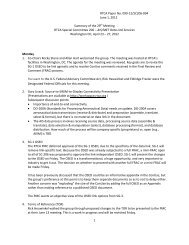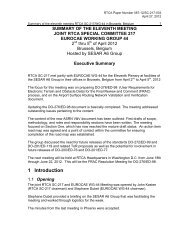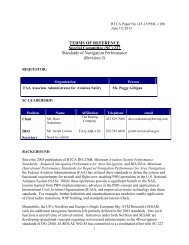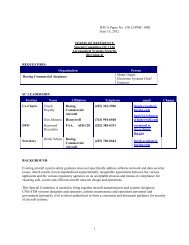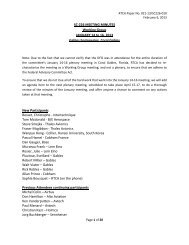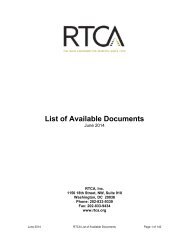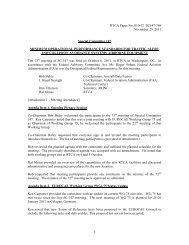Summary of the First Meeting Special Committee 227 ... - RTCA
Summary of the First Meeting Special Committee 227 ... - RTCA
Summary of the First Meeting Special Committee 227 ... - RTCA
Create successful ePaper yourself
Turn your PDF publications into a flip-book with our unique Google optimized e-Paper software.
Sylvain: if we currently have temperature compensation, we have no way to take credit for this.<br />
MarkS: <strong>the</strong>re is a note on some procedures that temperature compensation does not apply to systems that<br />
have compensation.<br />
Section 3.5 TOAC<br />
MikeJ: ETA min/max description is currently min/max speed, whereas SESAR / WG85 propose a 95%<br />
reliable definition. This area needs study to harmonize.<br />
Section 3.6 user interface<br />
MikeC / JohnH: Table 3-4 needs to be revisited<br />
Times to seconds, Altitudes, etc.<br />
Section 3.7.2.1.2<br />
Frank: we need to put something about user defined fixes in approaches and missed approaches, that this<br />
is not intended. We need this to be clear that this is not allowed. User defined fixes prohibited on<br />
instrument approaches and limited in use for departure procedures where obstacles or environment is an<br />
issue<br />
Frank: we should discuss a minimum requirement for automatic sequencing for missed approach<br />
transition, from TOGA to LNAV.<br />
Section 3.7.3 navigation aid selection<br />
JohnH: <strong>the</strong>re are parts <strong>of</strong> <strong>the</strong> navaid selection that needs fixing.<br />
Section 3.7.8 TOAC<br />
Frank: we will want to add discussion <strong>of</strong> single vs. multiple time constraint, and en-route vs. terminal.<br />
Sylvain: what does it mean to minimize throttle activity<br />
MarkH: we need to be careful commanding speeds near <strong>the</strong> edges <strong>of</strong> <strong>the</strong> envelope.<br />
Sylvain: we can have pilot entry <strong>of</strong> min/max RTA speeds to keep <strong>the</strong> RTA speeds away from <strong>the</strong> edges <strong>of</strong><br />
<strong>the</strong> envelope.<br />
MarkH: we may need to communicate <strong>the</strong>se limitations to ATC before we get cleared for something we<br />
can’t do. This should get done from dispatch time onwards.<br />
MikeJ: <strong>the</strong> ETA min/max capability is intended to cover this once <strong>the</strong> aircraft is airborne, to prevent <strong>the</strong><br />
issuance <strong>of</strong> clearances that cannot be complied with.<br />
MarkH: we should consider supporting two time constraints, one en-route, one terminal.<br />
Frank: we should tie <strong>the</strong> RTA tolerance to <strong>the</strong> flight phase.<br />
Sylvain: no we should not<br />
Frank: <strong>the</strong>re are issues with details <strong>of</strong> speed control that affect how <strong>the</strong> aircraft meet <strong>the</strong> time constraints.<br />
Section 4.2.3 TOAC performance<br />
Sylvain: wind modeling errors affects achievable performance<br />
Thursday, 3/8<br />
<strong>Meeting</strong> Schedule and Scope<br />
Dave presented two possible meeting schedules, 3 month or 2 month cycle and opened discussion related<br />
to picking meeting dates.<br />
The considerations raised:<br />
18




